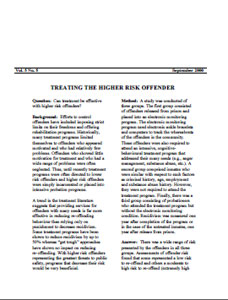Treating the higher risk offender
Research summary
Vol. 5 No. 5
September 2000
Question
Can treatment be effective with higher risk offenders?
Background
Efforts to control offenders have included imposing strict limits on their freedoms and offering rehabilitation programs. Historically, many treatment programs limited themselves to offenders who appeared motivated and who had relatively few problems. Offenders who showed little motivation for treatment and who had a wide range of problems were often neglected. Thus, until recently treatment programs were often directed to lower risk offenders and higher risk offenders were simply incarcerated or placed into intensive probation programs.
A trend in the treatment literature suggests that providing services for offenders with many needs is far more effective in reducing re-offending behaviour than relying only on punishment to decrease recidivism. Some treatment programs have been shown to reduce recidivism by up to 50% whereas "get tough" approaches have shown no impact on reducing re?offending. With higher risk offenders representing the greatest threats to public safety, programs that decrease their risk would be very beneficial
Method
A study was conducted of three groups. The first group consisted of offenders released from prison and placed into an electronic monitoring program. The electronic monitoring program used electronic ankle bracelets and computers to track the whereabouts of the offenders in the community. These offenders were also required to attend an intensive, cognitive-behavioural treatment program that addressed their many needs (e.g., anger management, substance abuse, etc.). A second group comprised inmates who were similar with respect to such factors as criminal history, age, employment and substance abuse history. However, they were not required to attend the treatment program. Finally, there was a third group consisting of probationers who attended the treatment program but without the electronic monitoring condition. Recidivism was measured one year after completion of the program or in the case of the untreated inmates, one year after release from prison.
Answer
There was a wide range of risk presented by the offenders in all three groups. Assessments of offender risk found that some represented a low risk to re-offend and others a moderate to high risk to re-offend (extremely high risk offenders were not included in the study). This range in risk was found in the conditional release and prison groups as well as the probationers. The results of the analyses found that the close supervision offered by electronic monitoring did not influence the rate of recidivism. The recidivism rate for the inmates released with electronic monitoring and the probationers who were matched on risk level were similar (31.5% vs. 35.3%).
The most important finding was that treatment was effective in reducing recidivism but only for the higher risk offenders. Higher risk offenders who received treatment, regardless of whether they were released inmates or probationers, had a recidivism rate of 31.6%. The inmates who were released from prison without attending the intensive treatment program demonstrated a recidivism rate of 51.1%.
Further analyses showed that low risk offenders who attended the intensive program recidivated at a higher rate than low risk offenders who did not participate in treatment (32.3% vs. 14.5%).
Policy implications
- Treatment directed at moderately high risk offenders can be effective in reducing recidivism. Providing treatment services to low risk offenders has questionable value. The findings from this study are consistent with other reports of a differential effect of treatment depending on offender risk level and highlight the importance of allocating treatment services to those who are most likely to benefit from such programs.
- Relying on punishment or repressive measures to deter criminal behaviour appears to have little support. Neither subjecting offenders to intensive monitoring or incarceration showed reductions in recidivism. Without a treatment component, "get tough" programs are unlikely to alter the criminal behaviours of moderately high risk offenders.
Source
- Bonta, J., Wallace-Capretta, S., & Rooney, J. (2000). A Quasi-Experimental Evaluation of an Intensive Rehabilitation Supervision Program. Criminal Justice and Behavior, 27, 312-329
For further information
James Bonta, Ph.D.
Solicitor General Canada
340 Laurier Avenue West
Ottawa, Ontario
K1A 0P8
Tel (613) 991-2831
Fax (613) 990-8295
e-mail jim.bonta@ps-sp.gc.ca
- Date modified:
